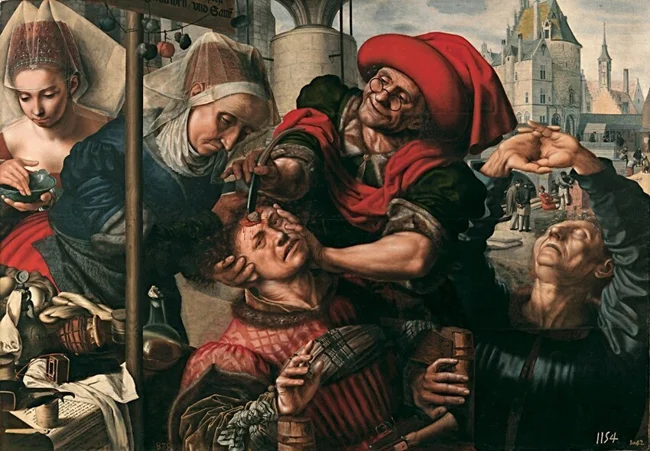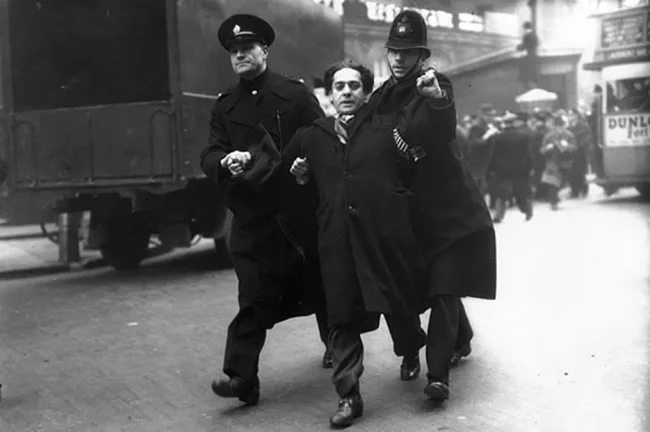The Face of Pure Evil and "Bitting Nuns". 5 cases in history when people went crazy en masse (5 photos)
A crowd of completely healthy people suddenly (including themselves) begins to dance. Or bite. Or fall into horror. 
Reminds me of the plot of a science fiction film from the “zombie apocalypse” series. However, there have been many such cases in history. They were called mass hysteria or psychosis.
Mass hysteria is a strange phenomenon where suddenly a group of people lose their ability to judge and start doing strange things. For example, experiencing non-existent symptoms. Or even hurt yourself.
According to psychologists, such phenomena occur due to people’s tendency to imitate and suggestibility. They are strengthened by the difficult situation in which the sick people find themselves. But when you read these historical facts, you still feel a little uneasy.
Biting nuns
In the 15th century, a strange madness occurred. The nuns began to bite each other, as well as the monastery staff. The "bite epidemic" spread to Holland and Rome. 
When the soldiers arrived to investigate the strange situation, the biting stopped. This happened only in a narrow circle. The madness stopped on its own. As it is written in medieval chronicles - from the exhaustion of the nuns.
This case of mass insanity and panic is far from the only one in history. Scientists still cannot explain the phenomenon of mass manias.
Modern psychiatrists believe that the nuns were overcome by so-called motor hysteria. This happens in closed groups with difficult living conditions. And it can drag on for months.
Meowing nuns
And again a case of mass insanity befell the nuns. The reason is the same - harsh living conditions and a closed team.
At the beginning of the 14th century, in one of the monasteries of France, a nun suddenly began to meow like a cat. Soon others began to imitate her. Moreover, the nuns began to gather in a room for several hours to meow together.
The event was risky. Especially for religious figures. At that time, in medieval Europe, cats were viewed negatively - they were exterminated, considering them to be the animals of Satan. Because they walk at night with glowing eyes.
Church authorities, under threat of physical harm, forbade the nuns to meow, and over time the nuns returned to normal.
Dance Plague
This story is even more paradoxical. And, alas, its consequences turned out to be much more serious.
In 1518, a woman named Troffea went out into the street in Strasbourg and began to dance. Soon several dozen more people joined her.
People danced and new “dancers” joined them. Within a month there were 400 people.
The doctors were puzzled. The council came to the conclusion that it was a fever. They did not dare to treat the sick, but suggested that they continue to dance until the fever went away on its own. We decided that the best cure was to let them dance all day long and everything would calm down.
The city governor built a stage and invited an orchestra and professional dancers to dance with the sick.
Since people danced without rest, everything ended sadly. Many died from heart attacks and strokes. They began to die simply from exhaustion.
There are many historical documents and doctor's notes on this event. Up to 15 people died per day.
Despite the insanity, many remained conscious, but simply could not stop. When other dancers began to die around them, some of the remaining crowded around the statue of St. Vitus and prayed for healing. Their dances were very emotional.
The term "St. Vitus's dance" entered medical practice to describe similar nervous symptoms. 
The situation was repeated many times throughout Europe. The last attack of the dance plague was recorded in the 17th century.
They were “treated” differently than in Strasbourg. Nobody started calling professional musicians. They tried to treat with the help of religious rituals. Oddly enough, the measure turned out to be effective - the epidemic was stopped faster and there were fewer victims.
This case remains a mystery. This can no longer be explained as simply as it was with the nuns.
Scientists believe that the insanity could be caused by poisoning with psychoactive ergot products. These are fungi that parasitize cereals. They contain alkaloids that are similar in chemical structure to LSD.
If ingested, alkaloids can lead to cramps and muscle spasms. They can also lead to mental disorders and vision problems.
In damp and cold years, ergot damage is especially active.
And yet, for a “month-long dance,” even such a psychoactive product does not look entirely convincing. At least sometimes the body should fall into a relaxed state. And over time, resistance to the substance could arise.
Epidemic of laughter
In 1962, three girls at a girls' boarding school in Tanzania began to laugh. They laughed for hours, unable to stop. The laughter spread to the other children, and they could not stop even in their lessons. The school had to be temporarily closed.
This is what I understand, contagious laughter!
Only schoolgirls were infected with laughter—the teachers did not react at all. The disease was nicknamed the “laughing flu.” 
Already recovered schoolgirls from Tanzania. Now they just smile
After a few months, 217 cases were reported in the area, before exceeding 1,000.
The disease then spread to other schools. Most of the victims were between 12 and 18 years old. Laughter in patients lasted from several hours to 16 days.
Everything stopped as suddenly as it began.
The conclusions that psychologists came to after analyzing the situation with recovered patients: this was caused by poor living conditions for schoolgirls. Their teachers were too strict. Terribly uncomfortable chairs and all the furniture in general. The dormitory had no windows. Any protests were suppressed. And this hysteria went like a chain reaction - their psyche could not cope with this situation and expressed protest in such an unexpected way.
"The Face of Pure Evil"
Chronologically, this is the last striking case of mass insanity. Occurred in a high school in Malaysia in 2019.
The schoolchildren began to shout sharply that they had seen “the face of pure evil.” Some of them pointed to the trees. This was not some kind of flash mob - the children were too sincerely scared and it was protracted. The school management cut down all the trees around.
This is how one of the first people to get sick, 17-year-old schoolgirl Siti Nurannisaa, describes the situation:
I was sitting at the table, feeling sleepy. And suddenly I felt someone tap me hard on the shoulder. She turned around, but didn’t see anyone. At that moment the room went dark.
I was overcome with fear. I felt a sharp pain in my back and felt dizzy. I fell to the floor.
And at that moment I looked into the “other world”. I saw scenes of blood, gore and violence. The worst thing I saw was the face of pure evil.
The children barricaded themselves in the classroom and screamed in horror. On the first day, mass hysteria struck 39 schoolchildren.
Doctor Robert Bartholomew suggested that the hysteria was caused by the school's strict adherence to Islamic law. "It's a collective stress response that causes overstimulation of the nervous system," Bartholomew explained in an interview with the BBC.
Thus, this case is closer in type to the situation with nuns in the Middle Ages.
Halifax Killer
This case is unique. If most of the previous stories can be attributed to difficult conditions of detention, religious strictness, etc., then the mass hysteria in Halifax (England) is not reasonably explainable. 
One of those arrested in the Halifax Killer case. Was subsequently released
The Halifax panic began on November 16, 1938. Two women, Mary Gledhill and Gertrude Watts, went to the local police station. They had wounds in the head area. The women said they were attacked by a mysterious man with a hammer and “bright buckles” on his shoes.
Moreover, the wounds looked more like razor cuts; it is unclear how they could have been inflicted with a hammer.
A few days later, more and more victims began to contact the police one after another. There were dozens of attacks, and the city was in panic. The attacker was nicknamed the “Halifax Killer” (more precisely, Slasher - from the word slash - to chop, cut. This word has many meanings, the main one of which is a killer who kills with the help of cutting objects). However, there were no cases of fatal attacks, which left the motive of the “Killer” a mystery.
Troops of volunteers began to walk the streets in search of the “Halifax Killer.” There was almost bloodshed. One of the squads suspected a local resident of the attacks. And he was almost subjected to lynching - the police saved him.
The police brought in experts from Scotland Yard. Experts interrogated the victims in detail. And they began to find small inconsistencies in the stories.
The first to crack was the injured man, Percy Waddington. He admitted that he caused the damage to himself. I couldn’t explain the motive, no matter how hard the police tried.
Within days, several other victims made similar confessions.
When nine victims admitted to harming themselves, police closed the investigation. Scotland Yard investigators concluded that there were no "murderous" attacks.
A similar story repeated itself in 1956 in Taiwan. Several dozen people went to the police with cut wounds. Taiwan has been terrorized by rumors of a crazed killer who roamed crowded streets and secretly slashed people with a razor blade as he passed by. After that he disappeared into the crowd.
This is not all cases. Mass hysteria affected everyone indiscriminately - both residents of developed countries (for example, an outbreak of Tourette syndrome among schoolchildren in New York in 2011) and people from poor countries.
Mass hysteria usually spreads quickly and its nature is not entirely clear. The peculiarity of mass psychoses, in contrast to collective delirium, is that there are obvious physical manifestations. One of the problems in studying such a phenomenon is the impossibility of setting up an experiment. You can only debrief on stories that have already happened.
According to physician and psychologist Robert Bartholomew, women and teenagers are more likely to experience mass hysteria than adult men.
“It is interesting that all recorded cases of mass mania and hysteria occurred in communities with high internal tension, and mainly in women. Stress accumulates, behavior is strictly regulated,” psychologist Evgeniy Idzikovsky told Popular Science.
As a result, someone loses their nerve and may have a nervous breakdown (strong religiosity especially provokes such breakdowns). Those around you are also on the verge and a chain reaction starts.
People tend to copy other people's behavior; we even have special mirror neurons to quickly read the state of those around us. And this behavior brings relief.
“You yourself can remember how it became easier for you if you lost your temper and allowed yourself to express your feelings in aggression or illogical actions,” sums up Idzikowski.





